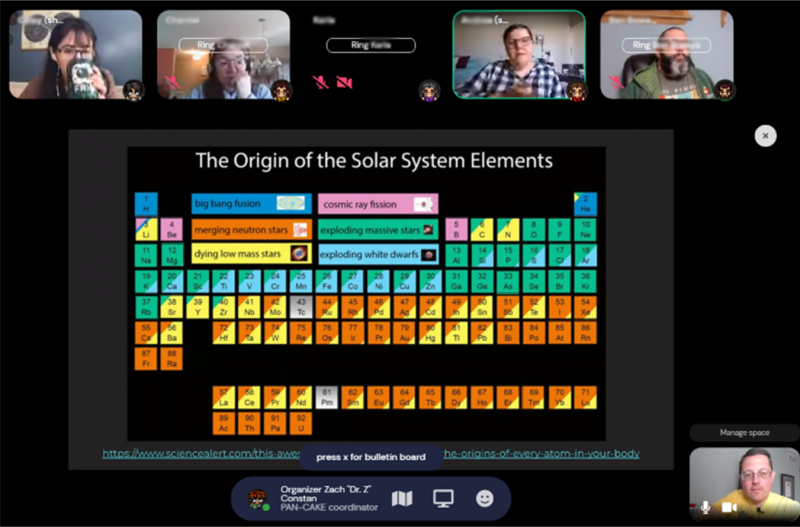Data
Physics of Atomic Nuclei Classroom Activities for Educators (PAN-CAKE) 2021

A condensed online version of JINA-CEE’s Physics of Atomic Nuclei (PAN) program hosted ~40 science teachers from twenty US states and Canadian provinces in March 13-14. The “PAN-CAKE” program took advantage of the innovative virtual learning strategies JINA-CEE has developed to provide a free professional development course that was accessible and convenient to fit around a school’s schedule. Eighteen volunteers representing JINA-CEE and the Facility for Rare Isotope beams (FRIB) worked alongside expert educators to design educational activities that equipped participants with the knowledge, tools, resources, and confidence necessary to incorporate nuclear astrophysics in their own classroom:
- Greg Severin's talk, titled "FRIB: Smashing Atoms with a Purpose", gave participants an overview of the laboratory, and highlighted how FRIB allows researchers to advance both societal applications and our fundamental understanding of the universe.
- In her talk, titled "Cooking up the Elements in Stars and in the Laboratory", Artemis Spyrou discussed the astrophysical observables that give us clues into how the Universe works, and the nuclear physics input that help us piece together the puzzle of the origin of the elements.
- Participants were able to explore the FRIB Laboratory on a virtual tour led by Zach Constan. Using "photospheres", they had exclusive access into research spaces and many locations that would normally be inaccessible during an in-person visit.
- "Discoveries before College", a talk by Paul Gueye, provided examples of strategies teachers could use with minimum effort and maximum impact to inspire students to pursue STEM careers.
- The Research Fair showcased short presentations on current work by research groups at FRIB and/or JINA-CEE. Topics included fission, decay modes, mass measurements of rare isotopes, types of dectectors and techniques for nuclear physics experiments, decay spectroscopy, astrophysical models and observations, nucleosynthesis and more.
- The Education Fair included presentations on ways to incorporate nuclear science and astrophysics into the high school curriculum. Topics included Rutherford scattering, nuclear structure, a preview of TINA (Training in Nuclear Astrophysics) — a new concept that makes research grade code and cutting edge topics available to the public for self-guided learning, opportunities for students, tools, demonstrations and ideas for classrooms, plus many more educational resources.

Coffee break at the virtual venue in gather.town
The recorded and live presentations from faculty were coupled with breakout discussions and Q&A sessions to encourage two-way communication with teachers. In the post-survey, all participants agreed that PAN-CAKE was useful and made them more interested in teaching nuclear science/nuclear astrophysics. They would also recommend the program to other teachers.
PAN-CAKE served twice as many teachers as any previous PAN program, which will impact the students they inspire for years to come. Many thanks to all of the volunteers who spent part of their weekend to promote nuclear astrophysics education!
